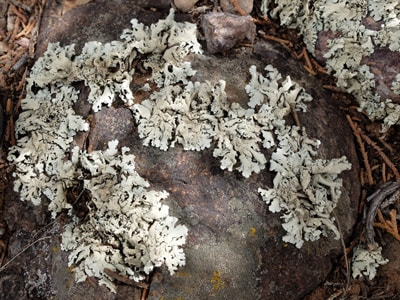|
Found on trees, logs, rock and soil
Seen in April at Abiquiu Lake So far this year it has been hard to find many plants in bloom, some Purple Mustard, a few Filaree and Dandelions. Although not a plant with a bloom, this pretty lichen on a rock caught my eye. Lichen are interesting and amazing organisms which are actually fungi that cultivate algae for survival. The algae provide the lichen with carbohydrates, vitamins and proteins, while the fungus provides the algae with protection from the elements. The lichen is the product of this symbiotic relationship. Although sometimes plant-like, they are not plants; they do not have roots, stems or leaves. They are slow-growing and can survive in harsh environments on trees, logs, rocks and soil, from hot deserts to the Arctic, and cover about 7% of the Earth’s surface. They convert carbon dioxide in the atmosphere into oxygen and can absorb pollutants in the air. Having lichens growing where you live is a good thing; it means the air you breathe is clean. Lichens have been used for many things by both animals and humans. They provide forage and shelter for elk, deer, birds, and insects. The rufous hummingbird uses it to build its nest. Humans use lichens for dyes, clothing, and decoration, including the tartans of Scotland. A few crofters still produce Harris Tweed using lichen. An added advantage over synthetic dyes is that bitter lichen acids repel moths. A variety of products use lichen in their ingredient lists today, for example, in deodorant, toothpaste, salves, extracts, and perfumes. In Japan, they use lichens in paint for its anti-mildew properties. Lichens in traditional medicine are most commonly used for treating wounds, skin disorders, respiratory and digestive issues, and obstetric and gynecological concerns. Source. There are about 20,000 known species of lichen, I think this is Salted Shield Lichen, Parmelia saxatilis, but I am no expert. An old naturalist joke to remember what lichen is: “Freddy the fungus and Alice the alga met and took a lichen to each other. She thought he was a fungi, but now their marriage is on the rocks.” If you trying to identify a different flower then you can check what other flowers bloom this month. If you cannot identify a flower from the website send a photo and where you took it to [email protected]. Read online for tips.
2 Comments
|
AuthorI am Marilyn Phillips, a native of England, whose love of nature and the outdoors from childhood brought me by a circuitous route to Crested Butte, Colorado in 1993 and 16 years later to northern New Mexico. My exploration of the many trails in these areas, my interest in wildflowers and photography, and career in computer system design came together in this creation. If you have any corrections, comments or questions, please contact me by email. Archives
September 2025
Categoriescopyright © 2020
|



 RSS Feed
RSS Feed